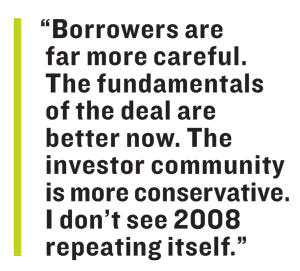Trending
The long view
Cory Gubner, founder of Rhys Commercial, discusses disbanding his brokerage to join NKF, his 30-year career in Stamford’s commercial sales market and why numbers can in fact lie

More than three decades navigating Stamford’s investment sales market have made Cory Gubner a grizzled industry veteran. The executive managing director of Newmark Knight Frank has lived through the booms and busts in a city that has seen more than its share of both.
Gubner first landed on the Stamford scene when he launched Chase Commercial Real Estate in 1998. Four years later, he sold the investment sales firm to commercial brokerage GVA Williams, where he was president and CEO until it merged into FirstService in late 2008. Gubner left a year later to start RHYS Commercial. (Rhys is Gubner’s middle name.)
But his most recent evolution came in December, when Gubner and some top RHYS executives disbanded their brokerage and joined the Stamford office of NKF, a global commercial real estate company with 16,000 employees and roughly 430 offices.
The Real Deal caught up with Gubner to talk about his latest move and the state of the Stamford market, which as of late is a bit of a mixed bag. In the fourth quarter, Stamford boasted Fairfield County’s highest average asking price at $52.42 per square foot, but it also had the county’s highest office vacancy rate at a bruising 34 percent, according to an NKF market report.
Still, things are not as bad as they look, said Gubner, noting that “very few other towns have the amount of large blocks that Stamford has.” This interview has been edited for clarity and length.
Smaller firms often cite slowing sales, rising costs and the influx of new technology when they agree to an acquisition by a larger commercial real estate player. Did toughening industry conditions force you into the arms of NKF? There has been a global change with real estate providers and clients demanding a certain level of service. They want a global reach when marketing a property. They want a tremendous infrastructure where financial services, market research, property management and property valuation are all available. It’s just impossible for a local boutique firm to have that kind of infrastructure in-house. For me and my team, it was important for us to service our clients as best we could, and that meant no longer being a boutique firm.
 You were captain of your own ship. Now you’re part of a global behemoth. Has the change been tough? I’m still in the same city that I was before, and I knew the [NKF] people who were in the [Stamford] office. There is great leadership here. There is great interaction and collaboration. One of the decisions to come to Newmark versus some other large firms was because of the base here. That has made the transition seamless.
You were captain of your own ship. Now you’re part of a global behemoth. Has the change been tough? I’m still in the same city that I was before, and I knew the [NKF] people who were in the [Stamford] office. There is great leadership here. There is great interaction and collaboration. One of the decisions to come to Newmark versus some other large firms was because of the base here. That has made the transition seamless.
Aren’t these tough times for Stamford’s commercial real estate market? That 34 percent vacancy rate paints a somewhat bleak picture. Thirty-four percent is a misnomer. There are some giant blocks of office space that make up for it. If you were to remove the former UBS building [empty since 2016, with 720,000 square feet of space] that alone would probably bring you down five percentage points or more. Add in the former Pitney Bowes [headquarters with 470,505 square feet] and some other large vacancies, and without those [the vacancy rate] would be in the mid-teens pretty quickly. Very few other towns have the amount of large blocks that Stamford has. That is skewing the numbers. Compared to other markets, Stamford is huge.
Can you break up the big blocks? Some blocks are easier chopped up than others. Building designs and layouts make it prohibitive from getting too small. There are a few large tenants that are floating around. I expect that two or so of the large blocks will be taken, and maybe not in their entirety, but a good bulk of them. So you’re going to see our vacancy rates come down a lot after 2019. It doesn’t take much to really get these numbers down quickly.
Have rising interest rates, stock market volatility, geopolitical unrest and government deadlock eroded confidence in the commercial market? Everything does have an effect on real estate, some things more than others. The overall economy has the greatest effect … Right now we’re at a good place. Interest rates have gone up, but they’ve stabilized and they’re still on the low side historically. The market is ripe for a lot of sales to happen.
It’s been a long time since the real estate bubble burst, and markets run in cycles. Is another shakeout looming? I’ve seen a few cycles in my 30-plus years of business, so I know what you mean. Things have peaks and valleys. I don’t see us heading in that direction. One of the reasons we went into the devastating cycle of 2008 had very little to do with actual real estate fundamentals. We’re in a much better place now. Properties are not overleveraged, and I’d argue they are underleveraged. Banks are far more careful. Borrowers are far more careful. The fundamentals of the deal are better now. The investor community is more conservative. I don’t see 2008 repeating itself.
Any advice for somebody starting at a commercial real estate brokerage? Make sure you are passionate about the business and you outwork everyone. Be the first in and last to leave. If you’re passionate, it won’t seem like work. If you’re passionate and outwork everyone, you will have a 100 percent success rate.
What is the single worst thing about commercial real estate? Losing a deal through no fault of your own.




